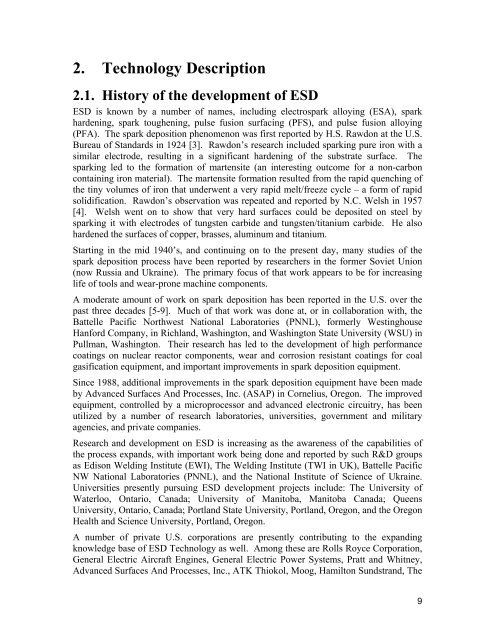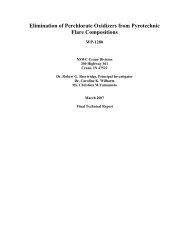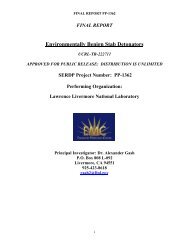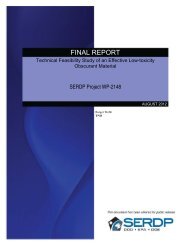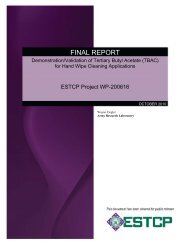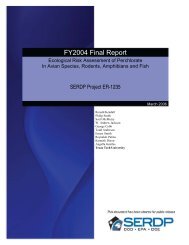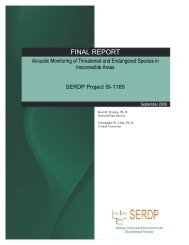Final Report - Strategic Environmental Research and Development ...
Final Report - Strategic Environmental Research and Development ...
Final Report - Strategic Environmental Research and Development ...
Create successful ePaper yourself
Turn your PDF publications into a flip-book with our unique Google optimized e-Paper software.
2. Technology Description<br />
2.1. History of the development of ESD<br />
ESD is known by a number of names, including electrospark alloying (ESA), spark<br />
hardening, spark toughening, pulse fusion surfacing (PFS), <strong>and</strong> pulse fusion alloying<br />
(PFA). The spark deposition phenomenon was first reported by H.S. Rawdon at the U.S.<br />
Bureau of St<strong>and</strong>ards in 1924 [3]. Rawdon’s research included sparking pure iron with a<br />
similar electrode, resulting in a significant hardening of the substrate surface. The<br />
sparking led to the formation of martensite (an interesting outcome for a non-carbon<br />
containing iron material). The martensite formation resulted from the rapid quenching of<br />
the tiny volumes of iron that underwent a very rapid melt/freeze cycle – a form of rapid<br />
solidification. Rawdon’s observation was repeated <strong>and</strong> reported by N.C. Welsh in 1957<br />
[4]. Welsh went on to show that very hard surfaces could be deposited on steel by<br />
sparking it with electrodes of tungsten carbide <strong>and</strong> tungsten/titanium carbide. He also<br />
hardened the surfaces of copper, brasses, aluminum <strong>and</strong> titanium.<br />
Starting in the mid 1940’s, <strong>and</strong> continuing on to the present day, many studies of the<br />
spark deposition process have been reported by researchers in the former Soviet Union<br />
(now Russia <strong>and</strong> Ukraine). The primary focus of that work appears to be for increasing<br />
life of tools <strong>and</strong> wear-prone machine components.<br />
A moderate amount of work on spark deposition has been reported in the U.S. over the<br />
past three decades [5-9]. Much of that work was done at, or in collaboration with, the<br />
Battelle Pacific Northwest National Laboratories (PNNL), formerly Westinghouse<br />
Hanford Company, in Richl<strong>and</strong>, Washington, <strong>and</strong> Washington State University (WSU) in<br />
Pullman, Washington. Their research has led to the development of high performance<br />
coatings on nuclear reactor components, wear <strong>and</strong> corrosion resistant coatings for coal<br />
gasification equipment, <strong>and</strong> important improvements in spark deposition equipment.<br />
Since 1988, additional improvements in the spark deposition equipment have been made<br />
by Advanced Surfaces And Processes, Inc. (ASAP) in Cornelius, Oregon. The improved<br />
equipment, controlled by a microprocessor <strong>and</strong> advanced electronic circuitry, has been<br />
utilized by a number of research laboratories, universities, government <strong>and</strong> military<br />
agencies, <strong>and</strong> private companies.<br />
<strong>Research</strong> <strong>and</strong> development on ESD is increasing as the awareness of the capabilities of<br />
the process exp<strong>and</strong>s, with important work being done <strong>and</strong> reported by such R&D groups<br />
as Edison Welding Institute (EWI), The Welding Institute (TWI in UK), Battelle Pacific<br />
NW National Laboratories (PNNL), <strong>and</strong> the National Institute of Science of Ukraine.<br />
Universities presently pursuing ESD development projects include: The University of<br />
Waterloo, Ontario, Canada; University of Manitoba, Manitoba Canada; Queens<br />
University, Ontario, Canada; Portl<strong>and</strong> State University, Portl<strong>and</strong>, Oregon, <strong>and</strong> the Oregon<br />
Health <strong>and</strong> Science University, Portl<strong>and</strong>, Oregon.<br />
A number of private U.S. corporations are presently contributing to the exp<strong>and</strong>ing<br />
knowledge base of ESD Technology as well. Among these are Rolls Royce Corporation,<br />
General Electric Aircraft Engines, General Electric Power Systems, Pratt <strong>and</strong> Whitney,<br />
Advanced Surfaces And Processes, Inc., ATK Thiokol, Moog, Hamilton Sundstr<strong>and</strong>, The<br />
9


